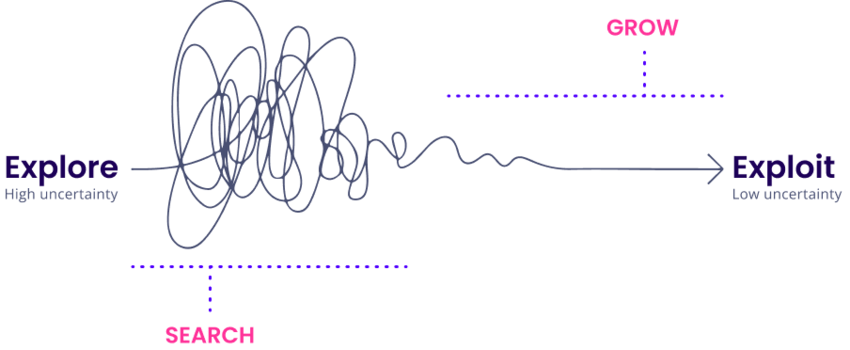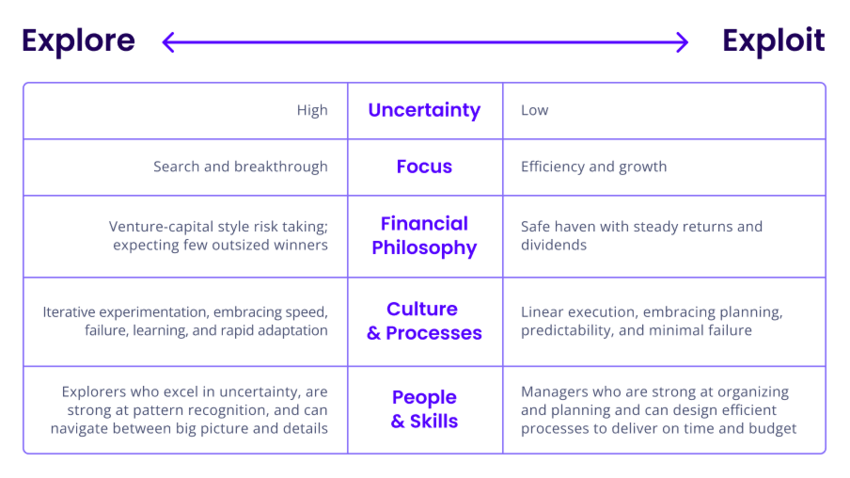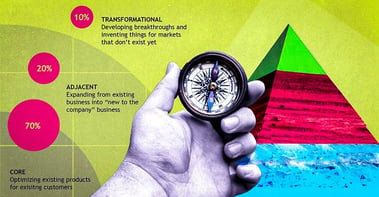The 2004 Harvard Business Review article “The Ambidextrous Organization” by Charles A. O’Reilly III and Michael L. Tushman starts with “The Roman god Janus had two sets of eyes — one pair focusing on what lay behind, the other on what lay ahead. General managers and corporate executives should be able to relate. They, too, must constantly look backward, attending to the products and processes of the past, while also gazing forward, preparing for the innovations that will define the future.” This is exactly what many organizations are struggling with today: Managing a proper balance between the past, today, and the future, between exploiting and exploring.
What is innovation ambidexterity?
Ambidexterity is the ability to use both hands with equal proficiency, an ability only very few humans ever master. In the context of companies, ambidextrous innovation refers to the ability to balance the exploration of new opportunities and the exploitation of existing capabilities. Ambidextrous organizations are able to simultaneously pursue incremental improvements to existing products and services, while also exploring new markets, technologies, and business models.
Why is ambidexterity in innovation important?
Research has shown that ambidextrous innovation can lead to superior performance for organizations. For example, a study conducted by He and Wong (2004) found that firms that were ambidextrous in their innovation approach outperformed those that focused solely on exploration or exploitation. Other studies have also found that ambidextrous innovation can lead to higher levels of innovation performance (Jansen et al., 2008; O'Reilly and Tushman, 2008).
There are several strategies that organizations can use to become ambidextrous in their innovation approach. One common strategy is to create separate units or teams that are responsible for exploration and exploitation. These teams can be given different resources, metrics, and incentives to support their respective objectives.
Managing continuous improvements (exploitation) and the exploration of new markets, technologies, and business models within the same team and responsibility space does not work well, as the objectives and especially the approaches to innovate are very different.
Striking the balance: Leveraging exploration and exploitation for innovation
Continuous improvement specifics (exploitation)
Continuous improvement methodologies include several specific techniques, such as:
Lean ManufacturingThis approach focuses on identifying and eliminating waste in the production process. Lean manufacturing aims to improve efficiency and reduce costs by minimizing non-value-added activities. To identify non-value-added activities and other “waste” in the production process, active feedback from the blue-collar workforce is essential. For this, ITONICS offers a mobile app for smartphones to feedback improvements and a very easy-to-use web interface to collect improvement ideas from everybody within the company.
Six Sigma
This methodology aims to reduce defects in products or services by identifying and eliminating their root causes. Six Sigma uses statistical analysis to measure and control the variability in a process, resulting in improved quality and customer satisfaction. Lean management primarily focuses on eliminating waste through tools that target organizational efficiencies while integrating a performance improvement system, while Six Sigma focuses on eliminating defects and reducing variation.
Total Quality Management (TQM)
This approach focuses on involving all employees in the quality improvement process. TQM emphasizes the importance of customer satisfaction and the continuous improvement of all organizational processes. TQM was largely supplanted by the ISO 9000 collection of standards and their formal certification processes in the 1990s.
Continuous improvement methodologies can be challenging to implement for several reasons. These challenges include:
1. Resistance to change:
Implementing continuous improvement methodologies often requires changes to established processes and procedures. Resistance to change from employees and stakeholders can hinder the implementation of these methodologies.
2. Lack of resources:
Continuous improvement methodologies typically require additional resources, such as time and money, to implement effectively. Organizations may struggle to allocate these resources, particularly if they are facing financial constraints.
3. Difficulty in measuring success:
Measuring the success of continuous improvement methodologies can be challenging, particularly if the benefits are intangible. Organizations may struggle to quantify the benefits of these methodologies, which can make it difficult to justify their implementation.
The ITONICS continuous improvement blueprints within our Ideation features support easy feedback processing addressing any continuous improvement methodology. Full transparency over the continuous improvement activities within a business unit, a production plant, or a country organization allows for benchmarking and drives an open feedback culture.
Even distributed, global organizations can radically level up their continuous improvement performance. This case study at construction giant Leonhard Weiss is a great example of a combined exploitation and exploration program based on the ITONICS Innovation OS.
Exploration specifics
Executing new business opportunities is oftentimes disruptive (if executed within a First Mover strategy). Disruptive innovations create new markets or significantly change existing ones. To take advantage of disruptive innovations, companies need to identify them early and take action.
Some of our clients call these approaches Moonshot challenges or Bold Bets. Even if innovation happens within a Fast Follower strategic approach, it is oftentimes transformational for certain business units within organizations. Challenges in more disruptive innovation activities are quite similar to the above-mentioned challenges in exploitation activities:
1. Resistance to change
Specifically in industries and businesses with high stability and a low susceptibility to future disruption, change is not seen as desirable. Why? The business has been doing great for a long time, and the risk of being disrupted is not very high.
2. Lack of resources
Identifying business opportunities for the short-, mid-, and long-term future from trends, emerging technologies, competitors, startups, and other sources is hard enough. Setting up and operating idea campaigns is even harder. Implementing the most promising concepts and taking an idea to market is really tough. All of these need proper resources, and in many organizations, these are hard to find.
3. Difficulty in measuring success
Success in transformational innovation is seen only over time. Investments today may result in success years later. Also, the more disruptive an innovation, the higher the risk of failure. Therefore, classic business KPIs are oftentimes not working out to measure success in explorative innovation.
ITONICS allows companies to identify opportunities by combining the so-called Market Pull and the Technology Push. The Market Pull reflects unmet or upcoming consumer needs. The Technology Push reflects emerging technologies making technology-enabled innovations possible.
Our continuous foresight approach integrates the Market Pull and Technology Push on one platform and allows for continuous opportunity identification. To explore these more transformational opportunities, ITONICS Campaigns allows crowdsourcing concepts, solution proposals, ideas, business models etc., on one global and intuitive software platform.
An amazing example is the CISCO Innovation Hub with 6 to 7 active challenges per month, generating more than a thousand ideas every year within well-defined opportunity spaces.
Combining exploitation and exploration
There are various ways to contextualize the more improving versus, the more disrupting innovation activities. Let’s look at the most important ones:
1. By ambition
This publication suggests a balanced innovation portfolio within three categories: Core, Adjacent, and Transformational innovation activities. The Core is all about optimizing existing products for existing customers (exploitation), Adjacent innovations are new to the company but not necessarily new to the market, and Transformational innovations are inventions that do not exist today (exploration).
Depending on the dynamics in a certain industry and market, the innovation portfolio can be configured, and rough guidelines on budget distribution defined. An example would be 70% into Core, 20% into Adjacent, and 10% of the innovation/ R&D budgets into Transformational projects in conservative industries like diversified chemicals or tires and rubber.
2. By personality
Exploration is oftentimes chaotic, frustrating, and exhausting, as the dynamic is high, and new trends and technologies pop up every few months. Think of the Metaverse hype or ChatGPT. Exploitation is much more structured but also limited at the same time. Having the right personality types for different innovation mechanisms is crucial for success.
3. By organization
Exploitation can be done very decentralized within a business unit, a plant, a market, or a brand. Nevertheless, it is important to share ongoing projects and successes to use synergies. Exploration, especially in the so-called Fuzzy Front-End of innovation, is ideally conducted by dedicated resources in a central function with direct ties to the strategy team or even embedded within.
But: having a single source of truth, a centralized innovation knowledge base, and transparent innovation roadmaps is crucial to keep all innovation activities in sync, (re-)calibrate the innovation portfolios, and identify synergies.
Overall, a company culture that values both exploration and exploitation is essential to be a successful innovator. This can involve promoting experimentation, tolerating failure, and encouraging collaboration across different parts of the organization. Leaders can also play a critical role in promoting ambidexterity by setting clear goals and priorities, communicating the importance of exploration and exploitation and providing the necessary resources and support to enable both.
Despite the benefits of innovation ambidexterity, there are also challenges to implementing this approach. One of the main challenges is managing the tension between exploration and exploitation. Organizations must be able to balance the need for experimentation and risk-taking with the need for efficiency and optimization. This can be particularly challenging for organizations that have established routines and processes that prioritize efficiency and predictability over innovation.
Another challenge is coordinating across different units or teams within the organization. For example, the exploration team may develop a new technology or product that the exploitation team is not equipped to commercialize. This requires effective communication and collaboration across different parts of the organization to ensure that a company can capitalize on new opportunities.

 Image source: Strategyzer, 2020
Image source: Strategyzer, 2020
Conclusion
Ambidextrous innovation is an important strategy for organizations that want to maintain their competitive advantage in today's rapidly changing business environment. By balancing exploration and exploitation, ambidextrous organizations can simultaneously improve their existing products and services while exploring new markets, technologies, and business models.
While there are challenges to implementing an ambidextrous approach, the benefits are substantial in terms of innovation performance and overall organizational success.
How does ITONICS help?
- All ideas, radical or improvements, big or small, local or global, can be managed on one collaborative platform. Various blueprints and best practices are available to start fast and to fit both exploration and exploitation. ITONICS Campaigns supports the identification of synergies, expertise, and knowledge on a global scale whilst catering to specific requirements in idea processing for various settings.
- The ITONICS Innovation OS supports all activities, from exploring opportunities to executing the most promising innovation projects.
- Innovation portfolios can be managed within one single point of truth. Centralized and decentralized innovation activities meet within ITONICS Innovation Roadmaps and Portfolios.
- Lean innovation governance and reporting become resource-efficient with built-in dashboards, alerting, and reporting features.










